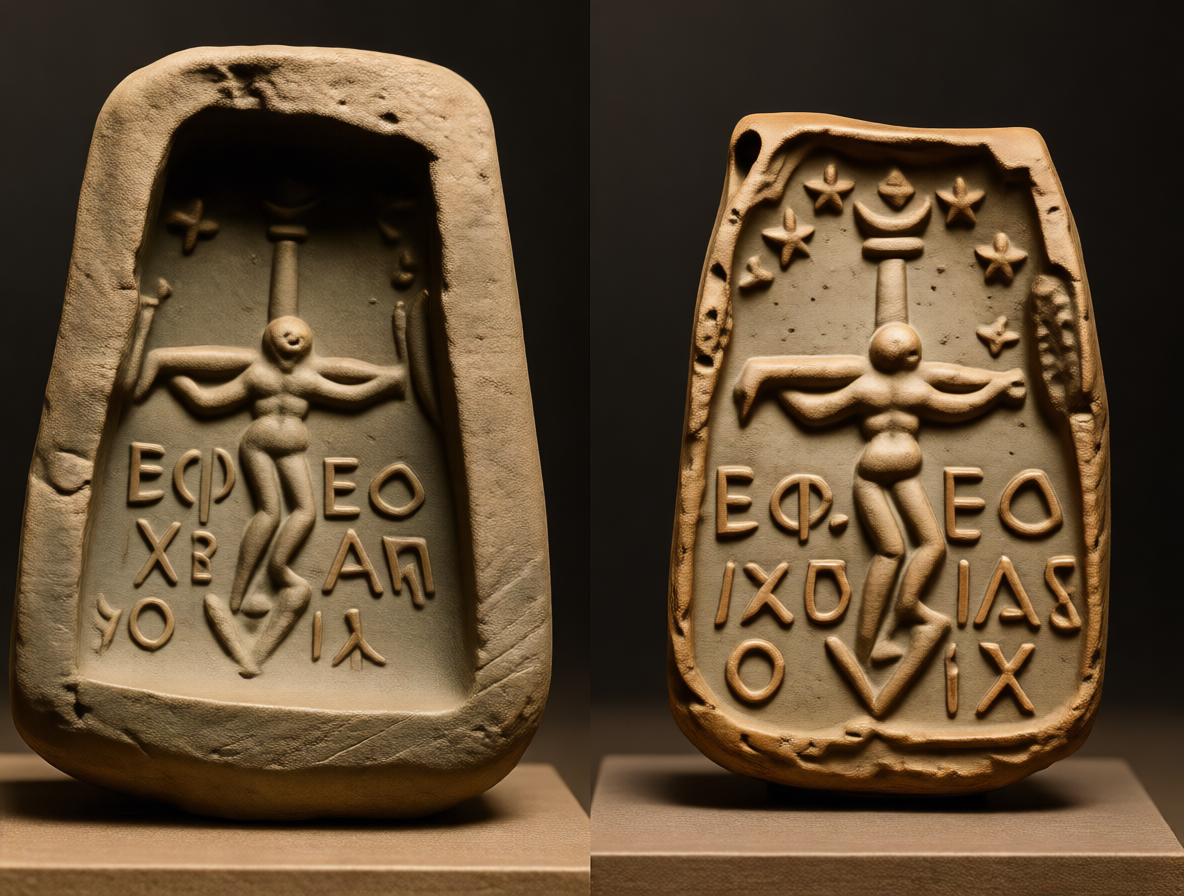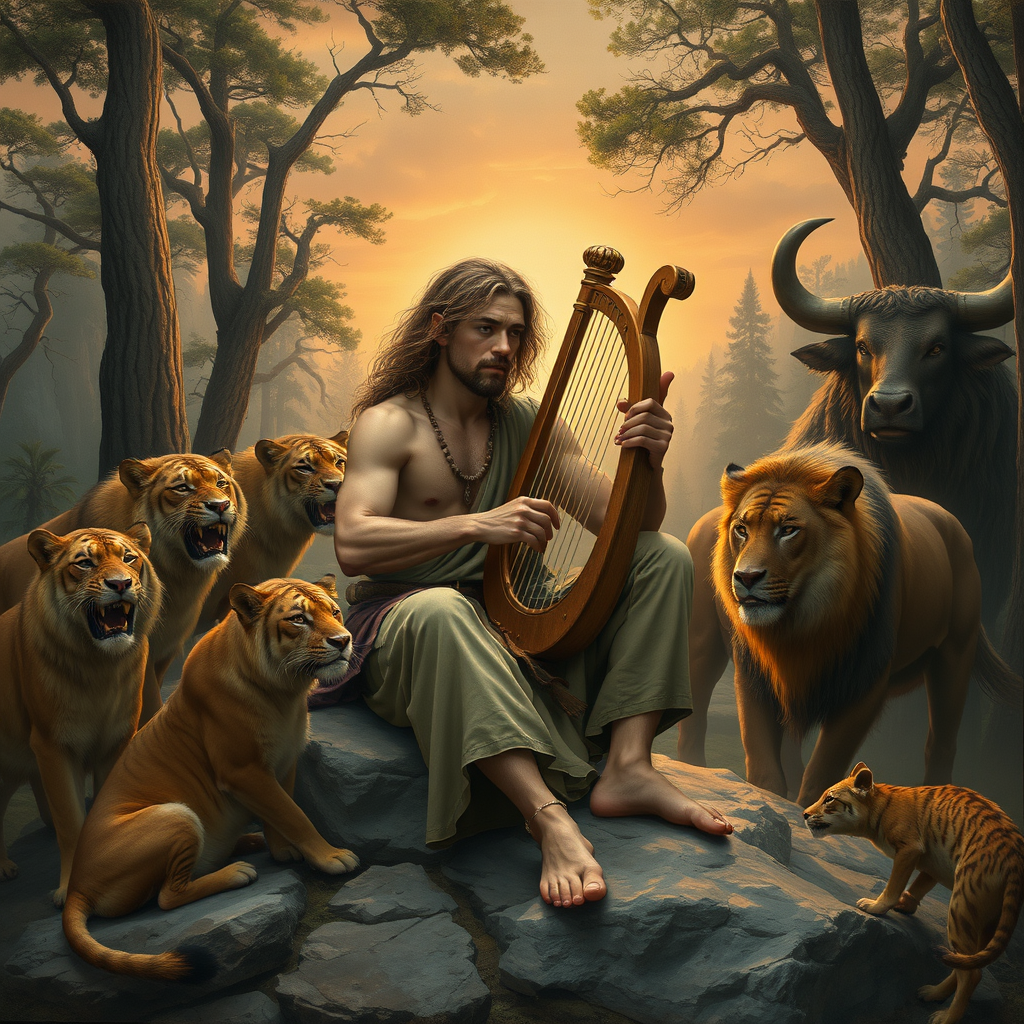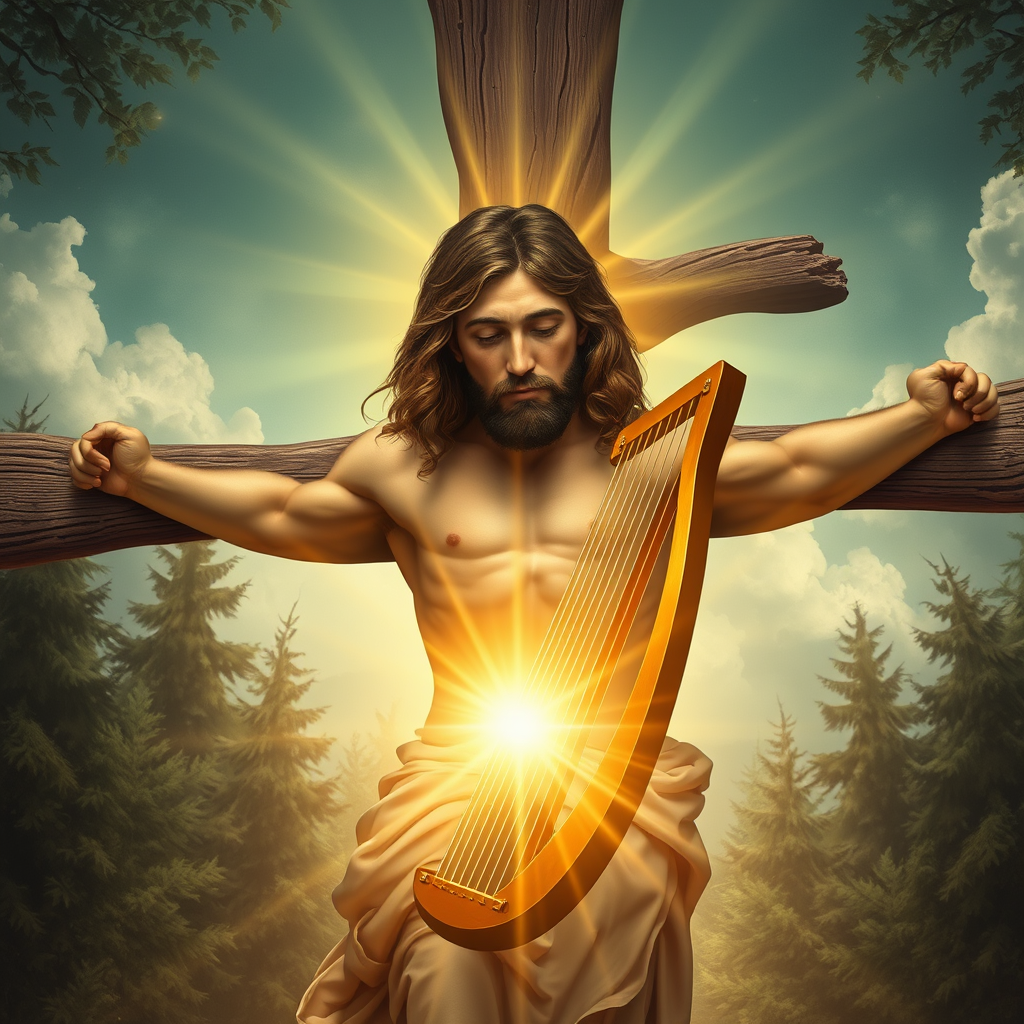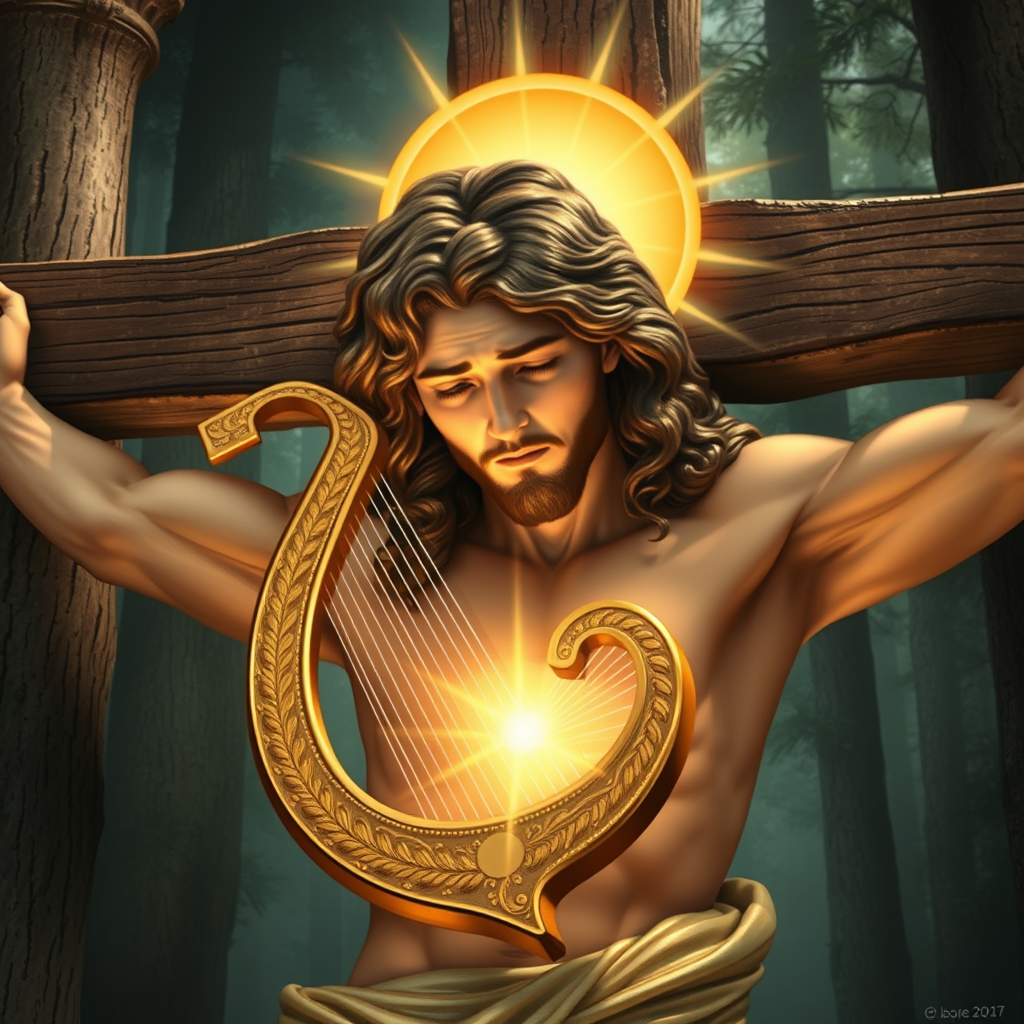The Crucified Orpheus Amulet: Pre-Christian Roots of Christian Symbolism

Among the most intriguing artifacts of antiquity is the so-called Crucified Orpheus Amulet — a small stone engraved with the image of Orpheus in a crucifixion pose. Scholars debate its meaning, but many see it as a key to understanding pre-Christian religious symbols later echoed in Christianity.
Orpheus in Myth: Youth, Talent, and Heroism
Orpheus is consistently depicted as a young adult in the myths, at the peak of his artistic and heroic powers. His youth and beauty are central to the stories, highlighting the idealized qualities that made him a legendary figure in ancient culture.
He enchants animals, humans, and even inanimate objects with the music of his lyre. This extraordinary talent demonstrates not only his artistic mastery but also his divine connection, as nature itself responds to his melodies.
Orpheus joins the Argonauts on their perilous quest for the Golden Fleece. His courage, resourcefulness, and leadership during the expedition further emphasize his heroic qualities, reinforcing his role as a figure of both action and inspiration.
Most famously, he descends into Hades to rescue his wife, Eurydice. This journey underscores his devotion, bravery, and extraordinary abilities, showing him as a character capable of confronting even death itself.
Ancient sources do not mention him growing old. The focus remains on his youth, beauty, artistic mastery, and heroic character, all of which are reflected in the symbolic imagery of the Crucified Orpheus Amulet.
Discovery and Description of the Amulet
The Crucified Orpheus Amulet is a small hematite gem, measuring approximately 9 × 14 mm, shaped like a truncated cone with perforated sides, allowing it to be worn as a pendant. On its front, the figure of a man is engraved in a crucified posture, arms outstretched horizontally and legs slightly bent, clearly evoking a crucifixion. Surrounding the central figure is a Greek inscription reading “ΟΡΦΕΟΣ ΒΑΚΧΙΚΟΣ” (Orpheos Bakkikos), which translates as “Orpheus Bacchic,” linking Orpheus to the Dionysian cult of Bacchus.
The engraving is finely detailed, showing careful attention to proportions, drapery, and symbolic motifs. The amulet’s small size and precise craftsmanship suggest it was a personal devotional object, intended for protection or spiritual guidance. As both a portable artifact and a symbolic representation, it reflects the sophisticated religious and mythological thought of pre-Christian Europe.
The Orphic Tradition and its Symbols
Orphism, a mystical religious movement emerging in Thrace and Greece, centered on Orpheus—the mythical musician who ventured into the underworld to rescue his beloved Eurydice. More than a poet, Orpheus became the spiritual founder of a mystery religion emphasizing the immortality of the soul, purification, and the promise of rebirth.
Central to Orphism was the idea of suffering as a path to transcendence. Initiates believed the soul was divine but trapped in the body, condemned to cycles of rebirth until liberated through ritual, knowledge, and devotion. Music, poetry, and sacred texts were means of spiritual ascent.
In this context, the image of Orpheus crucified can be seen as a symbolic representation of the soul’s suffering in the material world—a sacrifice that leads to transcendence. Such imagery echoes themes of death, suffering, and resurrection that would later define Christian theology.
Parallels with Early Christianity
The resemblance between Orphic themes and Christian motifs has long attracted scholarly attention. Both traditions emphasize:
Descent to the Underworld: Orpheus descends to Hades; Jesus descends after the crucifixion.
Sacrifice and Suffering: Orpheus suffers to redeem Eurydice; Jesus suffers for humanity.
Hope of Salvation: Both figures embody the promise of new life and spiritual liberation.
The amulet’s crucifixion imagery predates widespread Christian use of the crucifix by centuries. If Orpheus was depicted in a crucified posture before Christ, the question arises: did Christianity inherit or adapt existing symbols from Orphism?
While no direct evidence proves Christian borrowing, the parallels are striking. They suggest a cultural environment in which imagery of death, sacrifice, and resurrection was already circulating before Christianity emerged.
Scholarly Hypotheses and Debates
Interpretations of the Crucified Orpheus Amulet vary:
Symbolic Orphism: Some argue the image is purely symbolic, portraying the suffering soul bound to the material world.
Proto-Christian Syncretism: Others suggest early Christians, familiar with Orphic traditions, adopted and reinterpreted this imagery.
Later Christian Recasting: A minority view holds that the amulet could be a later reinterpretation, created after Christianity’s rise but attributing crucifixion imagery to Orpheus.
The dating of the artifact remains crucial. Some scholars place its origin before the first century CE, strengthening the case for pre-Christian symbolism. Others argue it could belong to the early centuries of the Common Era, during a time of religious syncretism when pagan and Christian symbols overlapped.
Disappearance and the Mystery of Hidden Relics
Like many controversial artifacts, the Crucified Orpheus Amulet has a mysterious history. Reports claim it was documented in European collections, but its present whereabouts are uncertain. Some speculate it was hidden or destroyed to avoid theological scandal, as the object challenges the uniqueness of Christian symbolism.
This pattern is not unusual: throughout history, artifacts that blur the boundaries between religious traditions have often been lost, concealed, or marginalized. Whether intentionally suppressed or simply misplaced, the disappearance of the amulet adds to its aura of mystery.
Conclusion
The Crucified Orpheus Amulet stands as a provocative symbol in the study of ancient religions. Whether it depicts Orpheus as a crucified savior figure, or simply a symbolic representation of the suffering soul, its existence highlights the porous boundaries between pagan and Christian traditions.
While scholars caution against drawing absolute conclusions, the amulet underscores the deep currents of myth, ritual, and symbolism that shaped the ancient Mediterranean world. In its enigmatic form, we glimpse not only the mysteries of Orphism but also the cultural soil from which Christianity emerged.
Images:
Orpheus from Greek mythology, a handsome young man with wavy hair and a melancholic expression, sitting on a rock at the edge of a sacred forest. In his hands he holds a shining golden and wooden lyre, playing it. Around him gather wild beasts — lions, wolves, tigers, and a mighty bull — all calmed and mesmerized by his music. The trees and stones seem to lean toward him, enchanted by the sound. A soft sunset glows in the background, creating a mythical, ethereal, and poetic atmosphere. Classical, detailed painting style inspired by Renaissance art.
Orpheus from Greek mythology, with wavy hair and a melancholic expression, sitting on a rock at the edge of a sacred forest. In his hands he holds a shining golden and wooden lyre, playing it. Around him, the wild beasts of the forest, listen in awe, while the trees seem to bend toward his music. A soft sunset glows in the background, creating a mythical, ethereal, and poetic atmosphere. Classical, detailed painting style inspired by Renaissance art.
Orpheus represented as a religious, Christ-like figure. A young man with wavy hair and a radiant, sorrowful expression, crucified on a wooden cross. Instead of nails, his hands delicately hold a shining golden lyre, symbolizing divine music and spiritual sacrifice. A glowing halo surrounds his head, and rays of light emanate from the lyre. Around him, the scene is both mythical and sacred, blending Greek and Christian symbolism — the forest fades into a heavenly, luminous background. Style: sacred iconography combined with Renaissance religious painting, solemn and transcendent.
Keywords / Key Phrases: Orphic amulet, crucified Orpheus, pre-Christian symbolism, Orphic mystery religion, ancient crucifixion imagery, syncretism before Christianity, Orpheus and Jesus parallels, hidden pre-Christian relics
Category: VISIONS | Page updated on: November 26, 2025
Author: Arxonyus
Discover also in VISIONS: individuality; ancient Thrace; perspective; visions; perspectives






